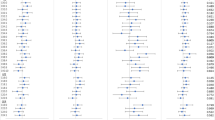Abstract
In this study of 20 moderately to severely depressed patients, diagnosed using current research diagnostic criteria and excluding known bipolar affective disorder and reactive depression, we investigated relationships between severity of depression and levels and ratios of n-3 and n-6 long-chain polyunsaturated fatty acids (PUFA) in plasma and erythrocyte phospholipids (PL). Severity of depression was measured using the 21-item Hamilton depression rating scale (HRS) and a second linear rating scale (LRS) of severity of depressive symptoms that omitted anxiety symptoms. There was a significant correlation between the ratio of erythrocyte PL arachidonic acid (AA) to eicosapentaenoic acid (EPA) and severity of depression as rated by the HRS (P<0.05) and the LRS for depression (P< 0.01). There was also a significant negative correlation between erythrocyte EPA and the LRS (P<0.05). The AA/EPA ratio in plasma PL and the ratio of erythrocyte long-chain (C20 and C22 carbon) n-6 to long-chain n-3 PUFA were also significantly correlated with the LRS (P<0.05). These findings do not appear to be simply explained by differences in dietary intake of EPA. We cannot determine whether the high ratios of AA/EPA in both plasma and erythrocyte PL are the result of depression or whether tissue PUFA change predate the depressive symptoms. We suggest, however, that our findings provide a basis for studying the effect of the nutritional supplementation of depressed subjects, aimed at reducing the AA/EPA ratio in tissues and severity of depression.
Similar content being viewed by others
Abbreviations
- AA:
-
arachidonic acid
- ALA:
-
α-linolenic acid
- EPA:
-
eicosapentaenoic acid
- HRS:
-
Hamilton rating scale
- LA:
-
linoleic acid
- LRS:
-
linear rating scale
- PL:
-
phospholipids
- PUFA:
-
polyunsaturated fatty acids
References
Klerman, G. (1988) The Current Age of Youthful Melancholia,Brit. J. Psych. 152, 4–14.
Klerman, G., and Weissman, M. (1989) Increasing Rates of Depression,JAMA 261, 2229–2235.
Budowski, P. (1988) Omega 3 Fatty Acids in Health and Disease,World. Rev. Nutr. Dietet. 57, 214–274.
Leaf, A., and Weber, P.C. (1987). A New Era for the Science of Nutrition,Am. J. Clin. Nutr. 45, 1048–1053.
Eaton, S.B., and Konner, M. (1985) Paleolithic Nutrition. A Consideration of Its Nature and Current Implications,New Eng. J. Med. 312, 283–289.
Endres, S. (1993) Messengers and Mediators: Interactions Among Lipids, Eicosanoids and Cytokines,Am. J. Clin. Nutr. 57 (Suppl.), 798–800.
Dolecek, T.A. (1992) Epidemiological Evidence of Relationships Between Dietary Polyunsaturated Fatty Acids and Mortality in the Multiple Risk Factor Intervention Trial,Proc. Soc. Exp. Biol. Med. 200, 177–182.
Smith, R.S. (1991) The Macrophage Theory of Depression,Medical Hypotheses 35, 298–306.
Hibbeln, J.R., and Salem, Jr., N. (1995) Dietary Polyunsaturated Fats and Depression: When Cholesterol Alone Doesn't Satisfy,Am. J. Clin. Nutr. 62:1–9.
Lieb, J., Karmali, R., and Horrobin, D. (1983) Elevated Levels of Prostaglandins E2 and Thromboxane B2 in Depression,Prostaglandins Leukotrienes Med. 10, 361–367.
DSM IV (1994)Diagnostic and Statistical Manual of Mental Disorders, 4th edn., American Psychiatric Association, Washington, DC.
Hamilton, M. (1960) A Rating Scale for Depression,J. Neutrol. Neurosurg. Psychiat. 23, 56–62.
Wheeler, C., Rutishauser, I., Conn, J., and O'Dea, K. (1994) Reproducibility of a Meal-Based Food Frequency Questionnaire. The Influence of Format and Time Interval Between Questionnaires,Europ. J. Clin. Invest. 48, 795–809.
Mann, N.J., Johnson, L.J., Warrick, G.E., and Sinclair, A.J. (1995) The Arachidonic Acid Content of the Australian Diet is Lower than Previously Estimated,J. Nutr. 125: 2528–2535.
Sinclair, A.J., O'Dea, K., Dunstan, G., Ireland, P.D., and Niall, M. (1987) Effects on Plasma Lipids and Fatty Acid Composition of Very Low Fat Diets Enriched with Fish or Kangaroo Meat,Lipids 22, 523–529.
Sinclair, A.J., O'Dea, K. and Johnson, L. (1994) Estimation of the n-3 Status in a Group of Urban Australians by the Analysis of Plasma Phospholipid Fatty Acids,Aust. J. Nutr. Dietet. 51, 53–56.
Lands, W.E.M., Libelt, B., Morris, A., Kramer, N.C., Prewitt, T.E., Bowen, P., Schmeisser, D., Davidson, M.H., and Burns, J.H. (1992) Maintenance of Lower Proportions of n-6 Eicosanoid Precursors in Phospholipids of Human Plasma in Response to Added n-3 Fatty Acids,Biochim. Biophys. Acta 1180, 147–162.
Bjerve, K.S., Brubakk, A.M., Fougner, K.J., Johnsen, H., Midjthell, K., and Vik, T. (1993) Omega 3 Fatty Acids: Essential Fatty Acids with Important Biological Effects and Serum Phospholipid Fatty Acids as Markers of Dietary W3-Fatty Acid Intake,Am. J. Clin. Nutr. 57 (Suppl.), 801–806.
Brown, A.J., Pang, E., and Roberts, D.C.K. (1991) Erythrocyte Eicosapentaenoic Acid versus Docosahexaenoic Acid as a Marker for Fish and Fish Oil Consumption,Prostaglandins Leukotrienes Essent. Fatty Acids 44, 103–106.
NHMRC (1992) Report of Working Party of the National Health and Medical Research Council,The Role of Polyunsaturated Fatty Acids in the Australian Diet, Australian Government Publishing Service, Canberra.
Nettleton, J.A. (1991) Omega 3 Fatty Acids: Comparison of Plant and Seafood Sources in Human Nutrition,J. Amer. Dietet. Assoc. 91, 331–337.
Ellis, F.R., and Sanders, T.A.B. (1977) Long Chain Polyunsaturated Fatty Acids in Endogenous Depression,J. Neurol. Neurosurg. Psychiatr. 40, 168–169.
Fehily, A.M.A., Bowey, O.A.M., Ellis, F.R., Meade, B.W. and Dickerson, J.W.T. (1981) Plasma and Erythrocyte Membrane Long Chain Polyunsaturated Fatty Acids in Endogenous Depression,Neurochem. Internat. 3, 37–42.
Author information
Authors and Affiliations
About this article
Cite this article
Adams, P.B., Lawson, S., Sanigorski, A. et al. Arachidonic acid to eicosapentaenoic acid ratio in blood correlates positively with clinical symptoms of depression. Lipids 31, S157–S161 (1996). https://doi.org/10.1007/BF02637069
Issue Date:
DOI: https://doi.org/10.1007/BF02637069




